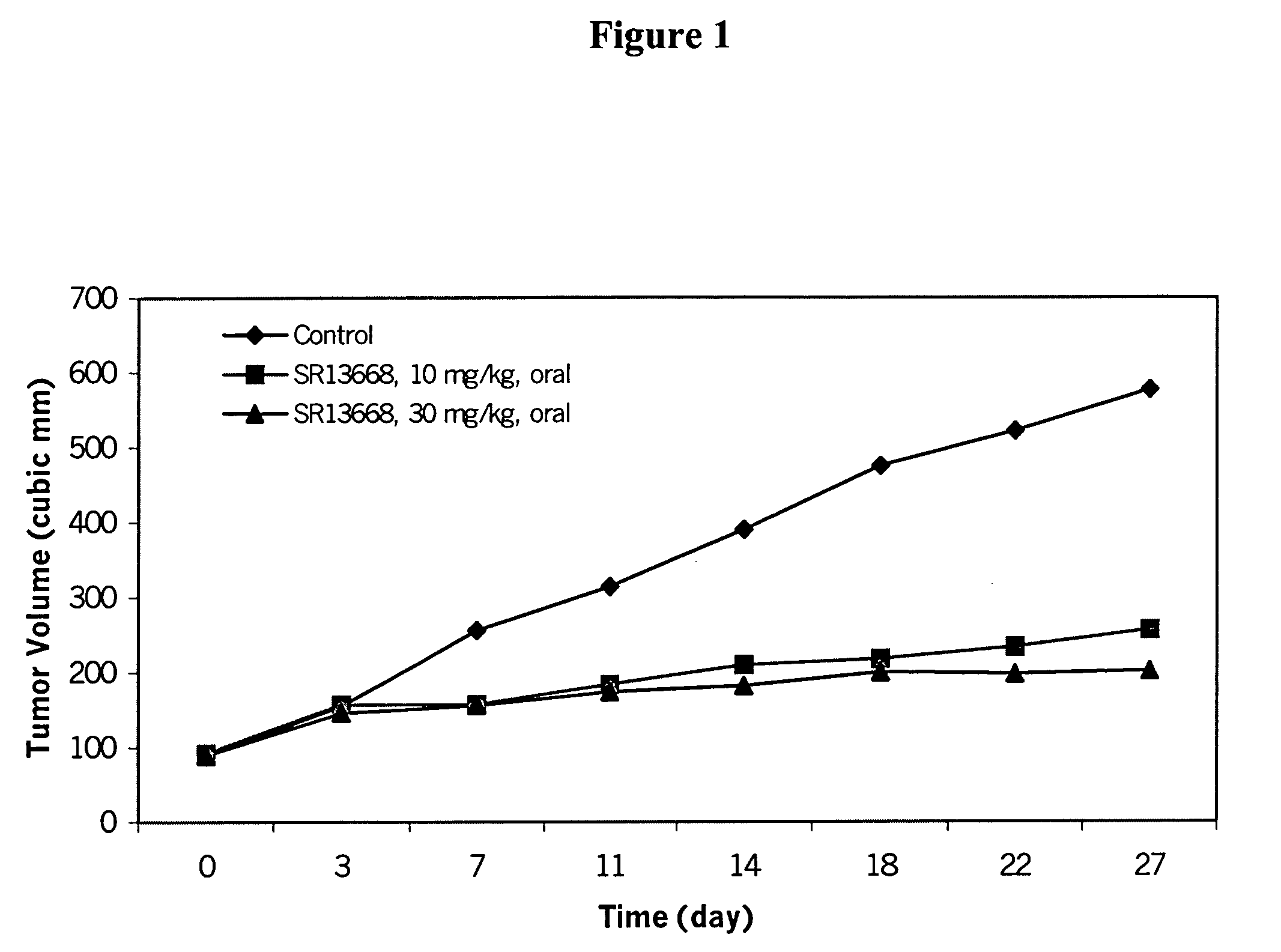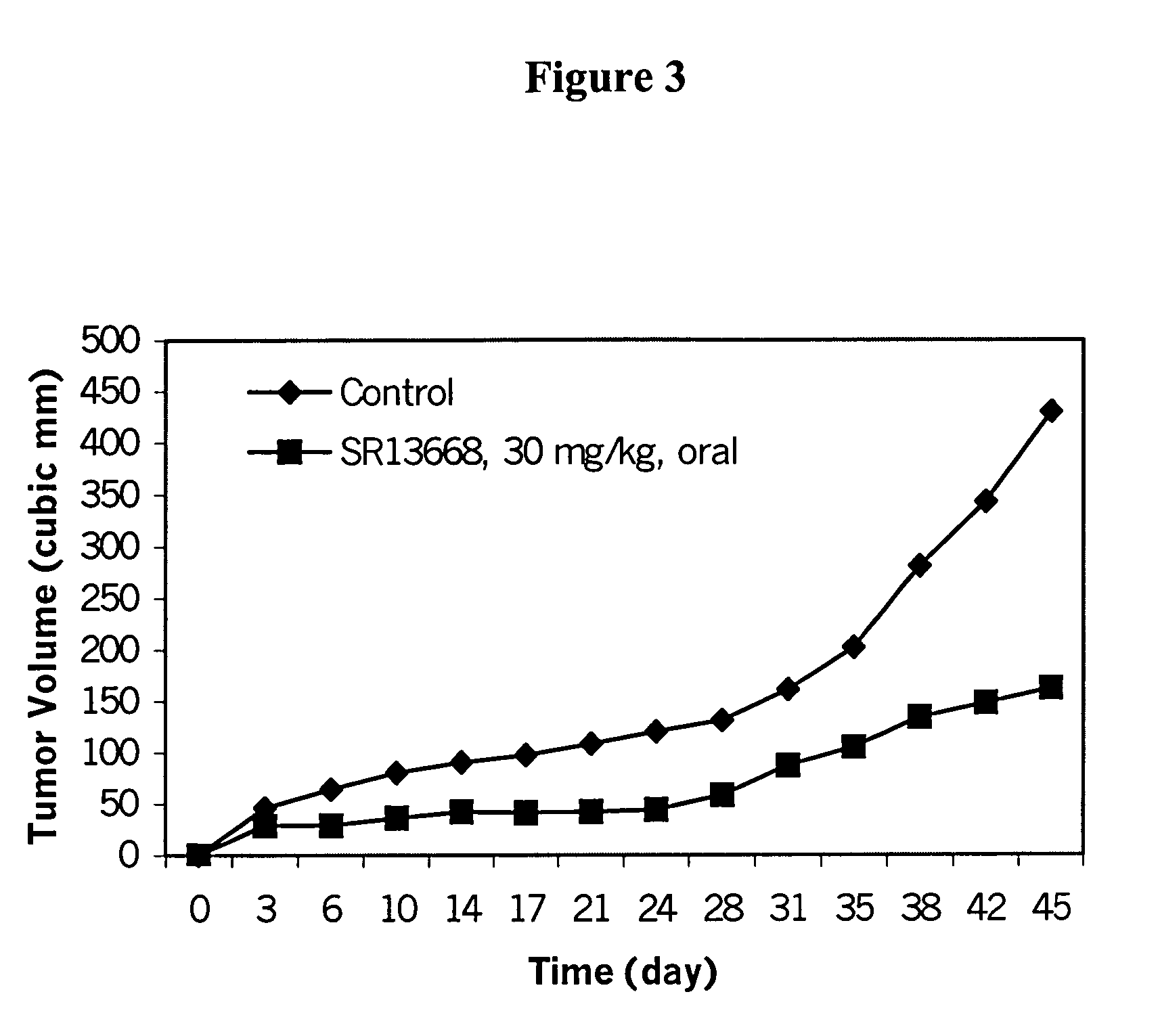Analogs of indole-3-carbinol metabolites as chemotherapeutic and chemopreventive agents
a technology of indole and metabolites, which is applied in the field of new dietary indole analogs, can solve the problems of recurrence of disease, high yield, and common recurrence of disease, and achieve the effect of high yield
- Summary
- Abstract
- Description
- Claims
- Application Information
AI Technical Summary
Benefits of technology
Problems solved by technology
Method used
Image
Examples
example 1
SYNTHESIS OF 2-CARBETHOXY-3,3′-DIINDOLYLMETHANE (6)
[0229](a) Ethyl 3-formyl-indole-2-carboxylate (2). To a mixture of N-methyl formanilide (4.2 g, 31 mmol) and phosphorus oxychloride (POCl3; 2.9 mL, 30.7 mmol) under argon was added ethylene dichloride (16 mL) and ethyl indole-2-carboxylate (1) (5.0 g, 26.4 mmol), and refluxed for 1.5 h. The reaction mixture was cooled to room temperature, poured into saturated aqueous sodium acetate (CH3CO2Na ), and the precipitate collected by filtration, washed with H2O, ether and dried under vacuum overnight to give the desired product 2 as a solid in quantitative yield (6.0 g): 1H NMR (300 MHz, CDCl3) δ 1.48 (t, J=7.1 Hz, 3, CO2CH2CH3), 4.54 (q, J=7.1 Hz, 2, CO2CH2CH3), 7.36 (m, 1, ArH), 7.45 (m, 2, ArH), 8.49 (d, J=8.2 Hz, 1, ArH), 9.33 (br.s, 1, NH), 10.77 (s, 1, CHO).
[0230](b) Ethyl 3-hydroxymethyl-indole-2-carboxylate (3). To a solution of aldehyde 2 (0.85 g, 3.9 mmol) in tetrahydrofuran (THF) (20 mL) was added sodium borohydride (NaBH4) (0....
example 2
SYNTHESIS OF 2,2′-DICARBETHOXY-3,3′-DIINDOLYLMETHANE (7)
[0232]2,2′-Dicarbethoxy-3,3′-diindolylmethane (7). To a mixture of 3-hydroxymethyl-indole-2-carboxylate (3) (0.4 g, 1.82 mmol) and ethyl indole-2-carboxylate (5) (0.42 g, 2.2 mmol) in CH2Cl2 (10 mL) was added (CF3SO3)3Sc (0.09 g) and stirred for overnight under argon. The solvent was evaporated to give a crude product, which was washed with H2O; ether and dried on vacuum overnight to yield the desired product 7 as a white solid (0.67 g, 94%): 1H NMR (300 MHz, CDCl3) δ 1.42 (t, J=7.1 Hz, 6, CO2CH2CH3), 4.48 (q, J=7.1 Hz, 4, CO2CH2CH3), 5.15 (s, 2, CH2), 6.91 (m, 2, ArH), 7.21 (m, 2, ArH), 7.33 (m, 2, ArH), 7.43 (m, 2, ArH), 8.75 (br.s, 2, NH).
[0233]Scheme II illustrates the reactions described in Examples 3 and 4:
[0234]
example 3
SYNTHESIS OF 5-CARBETHOXY-2′-METHYL-3′-DIINDOLYLMETHANE (12)
[0235](a) 2-Methylindole-3-carbinol (9). To a solution of aldehyde 8 (2 g, 12.56 mmol) in wet THF (30 mL) was added NaBH4 (0.71 g, 18.8 mmol) and stirred at room temperature for 1 h under argon. The suspension was quenched slowly with water and the organic layer was separated, dried (MgSO4) and concentrated to afford 9 as a solid (1.96 g, 97%): 1H NMR (300 MHz, CDCl3) δ 2.46 (s, 3, CH3), 4.84 (s, 2, CH2OH), 7.15 (m, 2, ArH), 7.29 (m, 1, ArH), 7.65 (m, 1, ArH), 7.92 (br.s, 1, NH).
[0236](b) 5-Carbethoxy-2′-methyl-3,3′-diindolylmethane (12). To a mixture of 2-methylindole-3-carbinol (9) (0.18 g, 1.12 mmol) and ethyl indole-5-carboxylate (10) (0.21 g, 1.1 mmol) in CH2Cl2 (5 mL) was added (CF3SO3)3Sc (0.05 g) and stirred for overnight under argon. The solvent was evaporated to give a crude product. Flash chromatography (30% EtOAc / hexane) yielded 12 as a white solid (0.32 g, 87%): 1H NMR (300 MHz, CDCl3) δ 1.43 (t, J=7.1 Hz, 3, C...
PUM
| Property | Measurement | Unit |
|---|---|---|
| temperature | aaaaa | aaaaa |
| temperature | aaaaa | aaaaa |
| volume | aaaaa | aaaaa |
Abstract
Description
Claims
Application Information
 Login to View More
Login to View More - R&D
- Intellectual Property
- Life Sciences
- Materials
- Tech Scout
- Unparalleled Data Quality
- Higher Quality Content
- 60% Fewer Hallucinations
Browse by: Latest US Patents, China's latest patents, Technical Efficacy Thesaurus, Application Domain, Technology Topic, Popular Technical Reports.
© 2025 PatSnap. All rights reserved.Legal|Privacy policy|Modern Slavery Act Transparency Statement|Sitemap|About US| Contact US: help@patsnap.com



